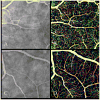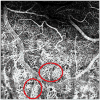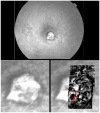Phase-variance optical coherence tomography: a technique for noninvasive angiography
- PMID: 24156929
- PMCID: PMC4190463
- DOI: 10.1016/j.ophtha.2013.09.002
Phase-variance optical coherence tomography: a technique for noninvasive angiography
Abstract
Purpose: Phase-variance optical coherence tomography (PV-OCT) provides volumetric imaging of the retinal vasculature without the need for intravenous injection of a fluorophore. We compare images from PV-OCT and fluorescein angiography (FA) for normal individuals and patients with age-related macular degeneration (AMD) and diabetic retinopathy.
Design: This is an evaluation of a diagnostic technology.
Participants: Four patients underwent comparative retinovascular imaging using FA and PV-OCT. Imaging was performed on 1 normal individual, 1 patient with dry AMD, 1 patient with exudative AMD, and 1 patient with nonproliferative diabetic retinopathy.
Methods: Fluorescein angiography imaging was performed using a Topcon Corp (Tokyo, Japan) (TRC-50IX) camera with a resolution of 1280 (H) × 1024 (V) pixels. The PV-OCT images were generated by software data processing of the entire cross-sectional image from consecutively acquired B-scans. Bulk axial motion was calculated and corrected for each transverse location, reducing the phase noise introduced from eye motion. Phase variance was calculated through the variance of the motion-corrected phase changes acquired within multiple B-scans at the same position. Repeating these calculations over the entire volumetric scan produced a 3-dimensional PV-OCT representation of the vasculature.
Main outcome measures: Feasibility of rendering retinal and choroidal microvasculature using PV-OCT was compared qualitatively with FA, the current gold standard for retinovascular imaging.
Results: Phase-variance OCT noninvasively rendered a 2-dimensional depth color-coded vasculature map of the retinal and choroidal vasculature. The choriocapillaris was imaged with better resolution of microvascular detail using PV-OCT. Areas of geographic atrophy and choroidal neovascularization imaged by FA were depicted by PV-OCT. Regions of capillary nonperfusion from diabetic retinopathy were shown by both imaging techniques; there was not complete correspondence between microaneurysms shown on FA and PV-OCT images.
Conclusions: Phase-variance OCT yields high-resolution imaging of the retinal and choroidal microvasculature that compares favorably with FA.
Copyright © 2014 American Academy of Ophthalmology. Published by Elsevier Inc. All rights reserved.
Conflict of interest statement
Figures






References
-
- Alvis D. Happy 50th birthday [letter] Ophthalmology. 2009;116:2259. - PubMed
-
- Marmor MF, Ravin JG. Fluorescein angiography: insight and serendipity a half century ago. Arch Ophthalmol. 2011;129:943–8. - PubMed
-
- Swanson EA, Huang D. Ophthalmic OCT reaches $1 billion per year. Retin Physician. 2011;8(4):45, 58–59, 62.
-
- Lipson BK, Yannuzzi LA. Complications of intravenous fluorescein injections. Int Ophthalmol Clin. 1989;29(3):200–5. - PubMed
Publication types
MeSH terms
Grants and funding
LinkOut - more resources
Full Text Sources
Other Literature Sources
Medical

